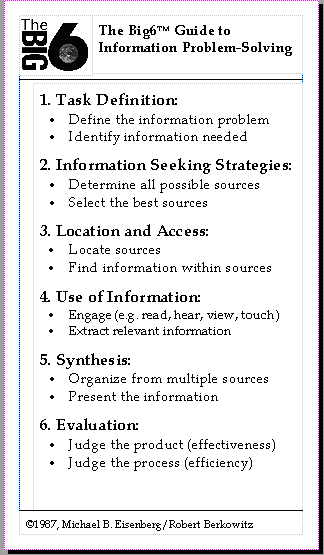Conducting
Research
- Plan the Research
- Identify the
topic.
- As a team, decide
what information you want to collect in order to solve
the problem.
- Establish
Criteria
- As a
team, agree on the measures on which you will base
your comparisons and decisions.
- For example, if
you need to choose a city, first identify the
standards for a suitable city.
- Clarify your
questions.
- What
questions do you need answered?
- This will help you
decide what information you need to
get.
- Stick to the
criteria.
- If the
information does not follow your criteria, maybe
you do not need it.
- Determine how to
divide the work.
- Who will
do what so that you make the most of your
time.
- Where will you find
the best information?
- The
Internet has a lot of information, but it is often
difficult to find what you need from the millions
of websites available.
- Encyclopedia
(CD-ROM or books) can give you a good
overview.
- A textbook can
give indepth information on a class
topic.
- A library book can
give indepth information on any topic.
- Magazines and
newspapers can also be useful.
- How will you manage
all the information you find?
- Gather
Information
- Take notes
if you are using books, magazines or
newspapers.
- If on the Internet or
using CD-ROM, notes can be copied right onto a word
processing program.
- Decide
what is useful.
- Divide information
into picture information, numeric information, and
text information.
- You can keep
information organized in a database or
spreadsheet.
- With numeric
information, you might want to create graphs and
charts to help explain.
- Organize
Information
- After data
is collected, sift through it.
- Sort the
data.
- Pull out what you
feel is most important.
- Organize data by
the criteria you set up.
- Can begin to
storyboard how information will be
presented.
- Synthesize
- Make sense
of the data you have collected.
- Make
connections.
- Draw
conclusions.
- Answer the
question(s) or solve the problem.
- Evaluate
- Decide if
your conclusions are correct.
- Have you
answered the questions or solved the problem to
your satisfaction?
- If yes, go on
to the next step.
- If not, then go
back in the cycle to any step you feel will help
you draw better conclusions.
- Reporting
- Decide to
whom you will be reporting your findings.
- Teacher
- Your
class.
- Other classes in
your school.
- Other classes
anywhere else.
- Parents.
- Business
people.
- Scientists.
- Legislators.
- City
Planners.
- Decide the best way to
share your findings.
- A website
that any can access.
- A live PowerPoint
presentation.
- An interactive
Hyperstudio stack.
- A dramatization (role
play)
- Other
- Finalize storyboard,
then begin
- Storyboard
is used to prepare for the presentation. Once the
storyboard is done, creating the final product will be
much easier and more organized.
- Here are a few sites
to visit to learn more about storyboarding:
- Imagine
Design Notes
- Storyboarding
Your Movie
- Storyboarding
Another wonderful research model for Middle
School is Big6:

Clicking on the card will take you to their website.
|
![]()
![]()
![]()
![]()
![]()
![]()
![]()
![]()
![]()
![]()
![]()
![]()
![]()
![]()
![]()
![]()
![]()
![]()
![]()
![]()
![]()
![]()
![]()
![]()
![]()
![]()
![]()
![]()
![]()
![]()
![]()
![]()